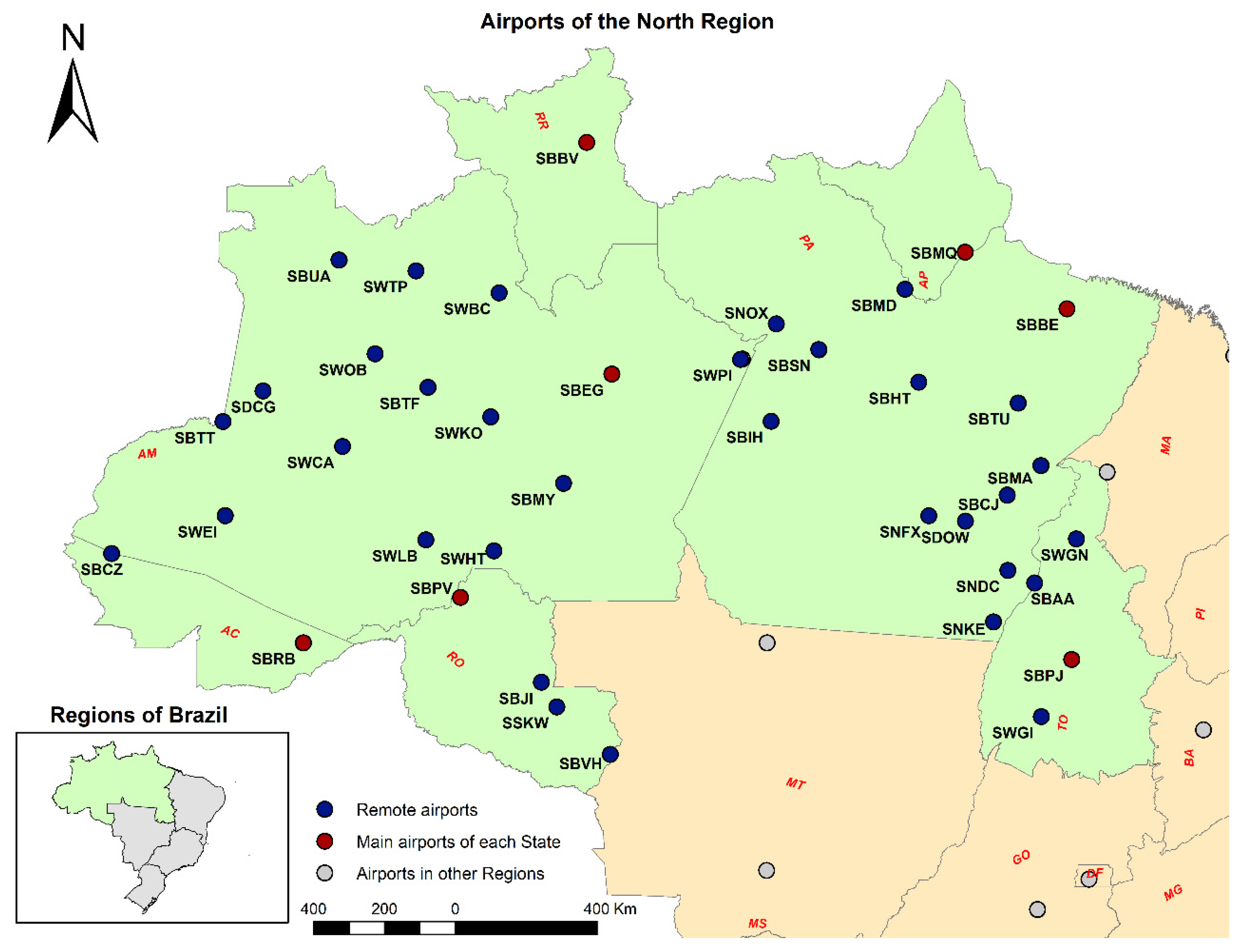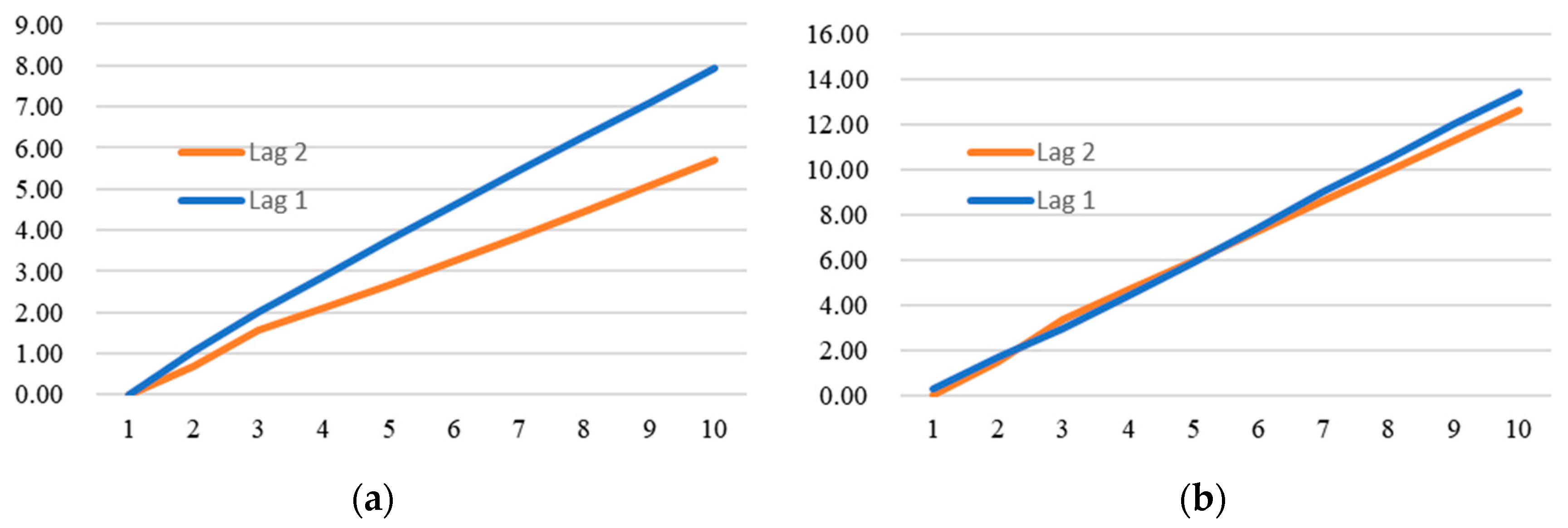2.1. Literature Review
There is a considerable amount of literature reporting on research into causality between air transport and economic growth. One of the main analytical tools for this, the Granger causality, which was conceived by the 2003 Nobel laureate in Economics, Clive William John Granger, is widely used in a variety of research fields, such as economics and business finance [
7,
8,
9], tourism [
10], and geography and transportation [
11,
12,
13]. However, studies addressing the issue of air traffic in remote areas and its relationship with the economic development of these regions are scarce.
In the field of air transportation research, the approach is usually to examine air traffic as a whole using, for example, movement at airports as the basis for analysis. The relations most examined are between airport passenger movement and employment and income, although there are studies on other issues. By and large, the studies of aviation and remote localities interlink with studies of regional aviation, on issues of subsidies: public service obligation (PSO), social services provided by state-owned airlines, and government essential air service (EAS) programmes. The studies are concentrated in specific areas of Asia, Australia, Europe, and North America. In these areas, the existing transport network is far more developed than in remote regions of Latin American countries. The literature review focuses on a set of articles selected to support the definition of the paper’s methodology. Among the studies reviewed, some examined below are more relevant to issues of the hinterlands of some of the regions mentioned.
Özcan [
14] sought to show causality between passenger air transport and possible effects on the composition of local employment in 31 Turkish provinces. Two-way causality was addressed by using a two-stage, least-squares estimation, deploying two instrumental variables. Özcan concluded that a 10% per capita increase in air passenger traffic would produce 15,013 service-related job positions in the 31 provinces considered. He reported that, in 2010, only 5 airports in Turkey were profitable. Assessment of the airport system on the basis of such financial records can be misleading, though, because it can conceal economic benefits of the air transport system that are hard to quantify.
Mukkala and Tervo [
15] endeavoured to determine the nature of the causality between air transport and the economy in peripheral portions of different types of regions of western Europe. Their analysis used annual data for 86 subnational regions in 13 countries from 1991 to 2010. Applying Granger causality analysis as their technical support, they obtained evidence of causality in those relations, suggesting that regional growth caused airport activity, while airport activity seemed to drive regional development. They reported that the same did not occur in the central regions, where airport activity did not cause regional growth, but regional growth did cause airport activity.
Özcan [
16] examined the economic contribution made to small and remote communities by flights under the essential air service programme (EAS). His estimation method revealed the existence of a statistically significant relationship between air passenger movement on regular commercial flights at an airport belonging to the EAS and per capita income in the locality. He found that a 1% increase in movement at an airport with minimum annual traffic of 1000 passengers may generate a 0.12% rise in the per capita income of the community in the airport influence area.
Baker et al. [
17] used the Granger methodology to examine empirically for catalytic impacts between regional air transport and economic growth in Australia. Their sample comprised annual passenger movement data from 88 airports and real aggregate taxable income. They found clear evidence of short- and long-term two-way Granger causality between these two variables. In the remote areas, they suggested that any public financial support to airports should be directed to themselves.
Van De Vijver et al. [
4] analysed causal links between volume of air passengers transported and regional development expressed as number of jobs in Europe. They applied Granger causality analysis to a sample from 112 areas of 18 countries, from 2002 to 2011. They suggested that caution should be used in stimulating local economic growth by expanding supply of air transport services, because such investments do not always result in compatible increases in employment.
Fageda et al. [
18] analysed the effect of prices and frequencies on air connectivity in remote regions under different public policies. They stressed that the possible positive effects of such policies should be balanced versus their costs, because they may entail very high public subsidies. They also noted that public policies need to play a substantial role in supporting air connectivity in remote communities.
The literature indicates that the relationship between air transport and regional economy differs in different regions of the world and that the Granger causality analytical methodology has proven suited to this kind of study. The lack of studies of Latin America, whose sub-regions display quite different conditions, leaves open the question of how this relationship works in Brazil’s North region, where the Brazilian Amazon is located. Fenley et al. [
19] discussed models of development in the region and showed that air transport can play a fundamental role, particularly as regards sustainable development. However, they did not examine for causal relations nor their possible impact.
2.2. Methodology
The three-stage methodology entailed, first, organising, describing, and cleaning the available data in line with the study objective. At this stage, the study sample was specified. The second stage involved analysing the data in order to specify the causality modelling to be applied. The third stage was to calculate and analyse the short- and long-term causality indicators, which would reveal the levels of impact among the variables used.
Granger [
20], who set out the fundaments of the analytical methodology selected for this study, maintained that simple correlation between historical series does not indicate causality. Soytas and Sari [
21] argued that, by demonstrating the statistical precedence of one historical series over another, this methodology indicates causality in the historical period studied. Not only the indicators calculated by applying the methodology, but also the rational argument regarding the relationship between the series in question, are fundamental to accepting such causality. Since its original formulation, the methodology has undergone new developments several times and is well documented in the academic literature, e.g., in Hsiao [
22] and Washington et al. [
23]. The corresponding analytical procedures are now available in freeware and commercial software, including Eviews, Mathlab, and R. Accordingly, this paper uses the analytical sequence of the Granger causality methodology. This sequence involves analysing stationarity, cointegration, and causality between economic series and air passengers at remote towns in Brazil’s Amazon region. The dynamic impact among the variables is analysed by impulse response (IR) and variance decomposition (VDC) indicators of the causality modelling.
Stationarity is the first condition to be met in analysing the time series. If stationarity is not confirmed, the series must be transformed. The first transformation often used in such analyses is applying the natural logarithm to the series. The second is the differences in values from one period to another. Maddala and Wu [
24] propose the Levin, Lin, and Chu and PP-Fisher tests to evaluate the number of differences necessary to make the non-stationary series, I(1), stationary, I(0).
In the second step, cointegration testing of the series determines whether they have a linear combination that is stationary. If the tests encounter cointegrating equations, then the hypothesis of long-run relations between the series is confirmed. The presence of cointegrating equations between the series recommends using the error correction model (ECM) as the instrument for analysing Granger causality [
25,
26]. Johansen [
27,
28] specified estimation of a p-order vector autoregressive (VAR) model as a suitable instrument for testing for cointegration between historical series. Equations (1) and (2) show a formulation used to examine for cointegration as proposed by Johansen.
where
is a k-vector of non-stationary variables I(1);
is a d-vector of deterministic variables;
is an innovation vector.
Engle and Granger [
25] set out the bases for analysis on the Granger theorem, as in Equations (1) and (2), which identify the number of cointegration relations for each test proposed by Johansen [
27,
28]. The Johansen cointegration test considers two parameters in specifying each test: the first regarding trend (e.g., none, linear, quadratic) and the second, whether or not to use an intercept. The number of cointegration vectors is determined using likelihood ratio testing known as the trace statistic.
In the event the series are not cointegrated, the direction of causality can be determined by the F-standard test on the VAR. That is achieved by estimating the bivariate equations (Equations (3) and (4)):
for all possible pairs of the series (
x,
y) in the group. Thus, the Wald F-statistic test is used to detect whether Granger X causes Y (Hassapis et al. [
29]; Toda and Phillips [
30,
31]) for the joint hypotheses (5).
As mentioned above, if cointegrating equations are identified for the series, the ECM should be used. This can be represented by Equations (6) and (7), whose coefficients and statistical significance tests indicate the short- and long-run relations between the series.
In Equations (6) and (7),
λ is a constant and the lags considered for the series in the short-run analysis are represented by
i and
j. These lags must be sufficient for the disturbance term,
, to be white noise. The estimated coefficients
’s of
and
’s of
with their statistical significance tests provide the bases for analysing the immediate impacts on the dependent variables,
and
, i.e., the short-run analysis. The coefficients of this analysis represent the expected short-term elasticities.
is the cointegration vector (Equation (8)), whose coefficient,
φ, gives the dimension of long-run speed of adjustment between the series. The long-run elasticity of
Y with respect to
X is estimated as
of the cointegration vector (Equation (8)). In these analyses, the level of significance of each of the coefficients is given by
t-statistic tests.
The appropriate number of lags is an issue in time series analysis. The causality methodology imposes constraints on the observed data because only a small proportion of the sample data can be used, i.e., only those data that satisfy all the conditions set. The larger the number of lags used in the analysis, the smaller the number of observations available will be. Several scholars point out methods to determine a model’s optimum lag length (Davidson and MacKinnon [
32]; Hakim and Merkert [
33]; Maddala [
34]). The study period was 6 years and unbalanced panel data were used. The study sample does not allow an application of the methodologies to optimise the number of lags. Accordingly, analyses based on 1 lag and 2 lags were performed, which was considered appropriate to the sample data characteristics.









